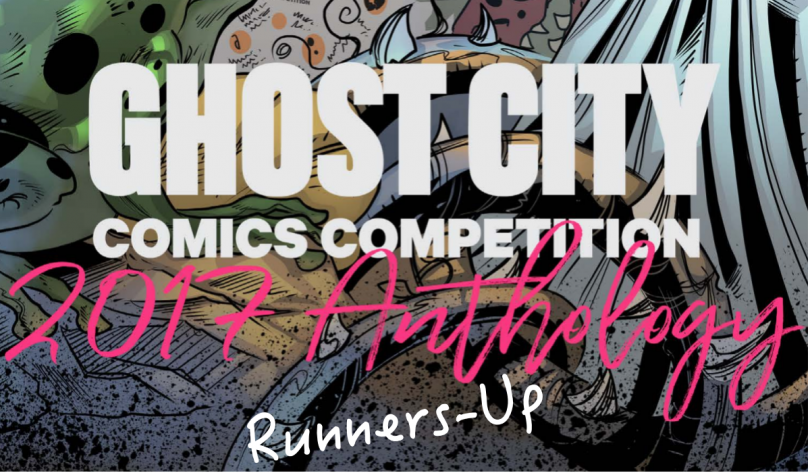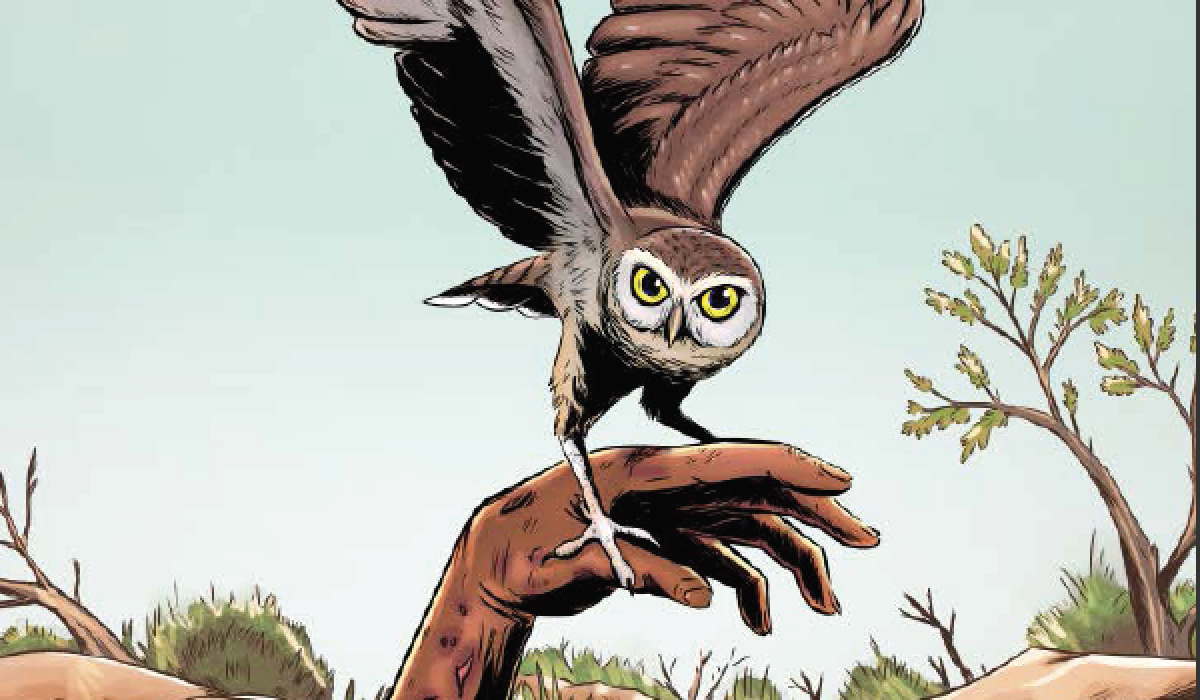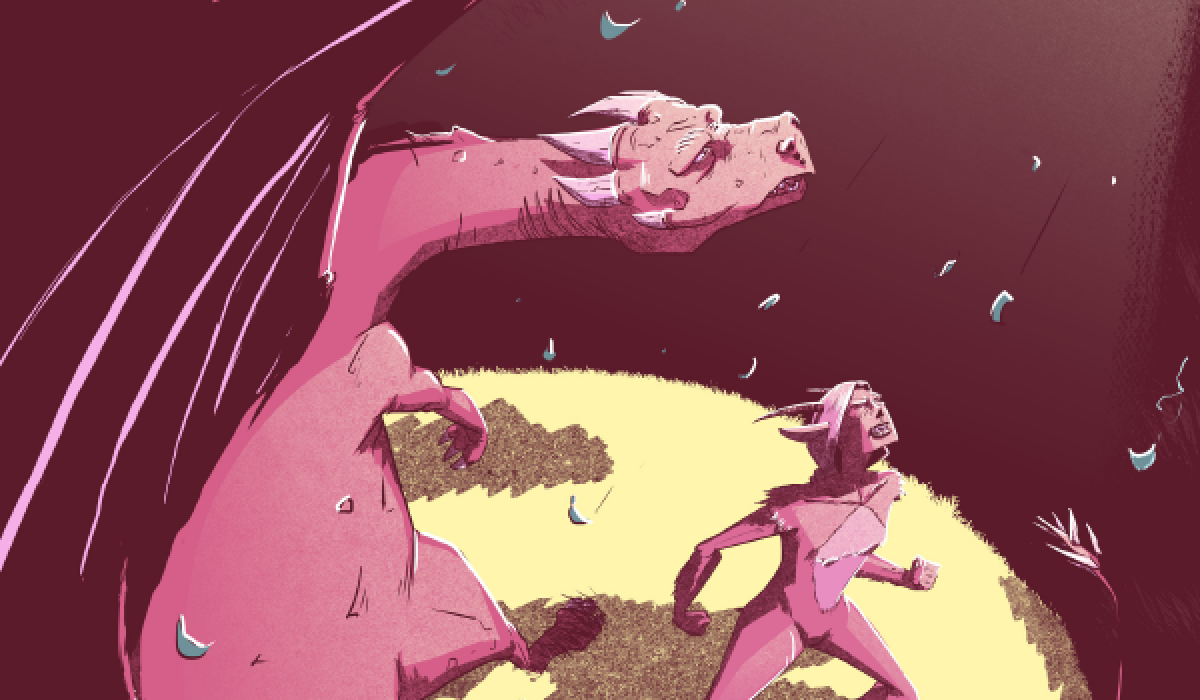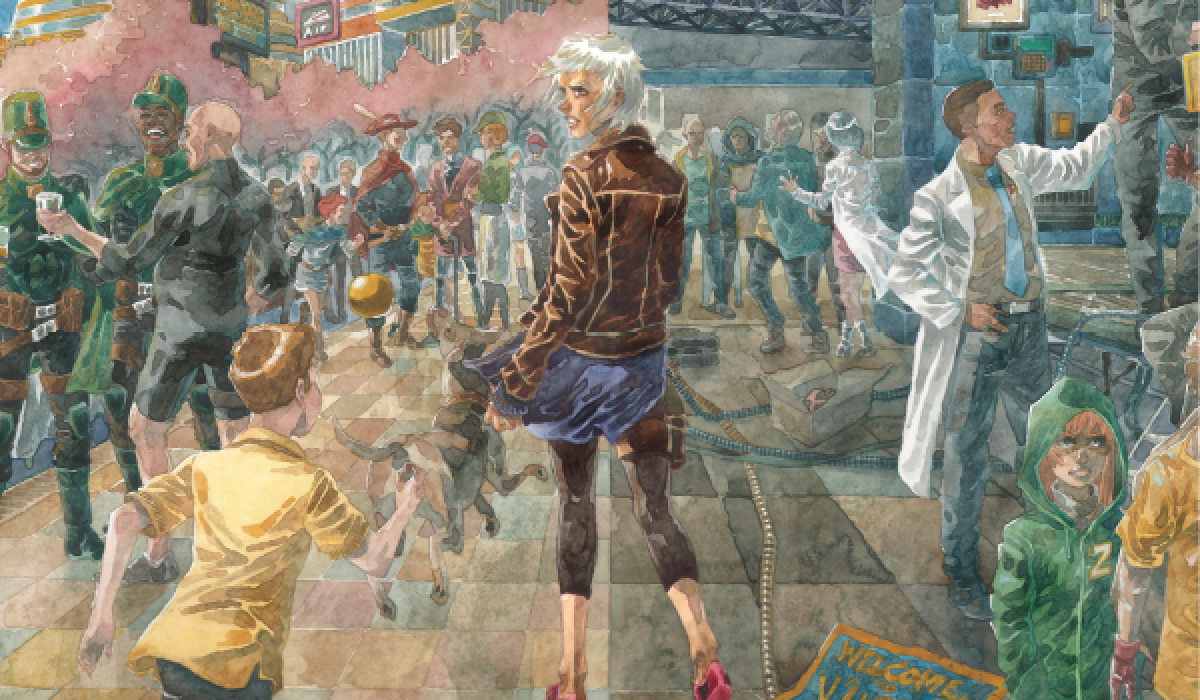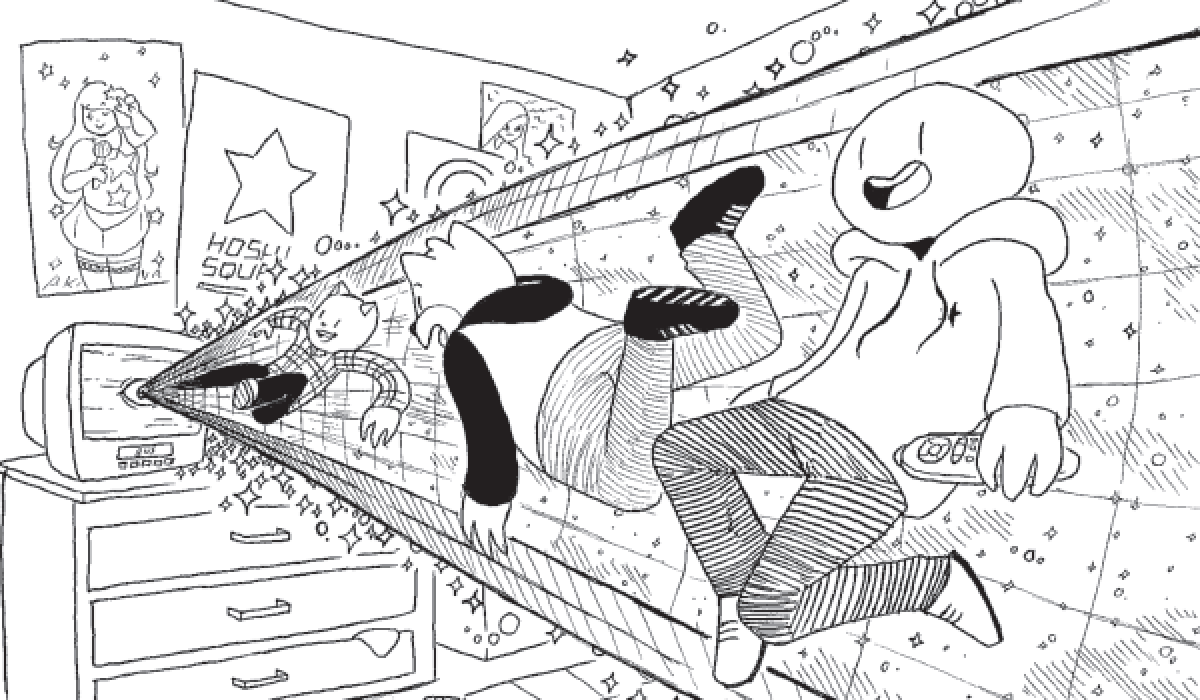A Place to Hang Your Cape is a proud supporter of the 2017 Ghost City Comics Competition: a great event that highlights some of the best indie comic creators out there. Here, we’d like to feature the eleven runners-up for Best Single Issues. These comics comprise a diverse group of genres, art styles, writing styles, and themes. Some are comedic, some dramatic, and all show a tremendous amount of work and dedication. Quite frankly, they are finalists for a reason. I won’t blabber on for too long here- we do have eleven mini-reviews to get to- but if you do want to check out more of these creators’ work, click the Ghost City Comics link above and see all the entries there.
A Love to Die For
Glenn Moane
The subtitle of this issue tells you everything you need to know: A miniseries about murder, lust, and closure. With that promise in mind, A Love to Die For is a gripping first chapter of a murder mystery. A distraught father kidnaps the ex-boyfriend of his murdered daughter and attempts to get a confession from him. We see the night of the murder from the ex’s perspective, initially clouding our judgement from blaming him outright. But as the interrogations proceed, details are questions, the father’s actions become more extreme, and a dramatic final panel throws a wrench into everything we assumed so far.
This comic reads like an emotional stageplay and leaves the reader desperately wanting parts two and three of the miniseries. The artwork and pacing both heighten the brief spurts of violence exchanged between the ex-boyfriend and his captors, as everything we see is covered in a thick fog of moral ambiguity. This story feels very realistic, despite a plot that could have come from a soap opera or the CW show Riverdale. Overall, A Love to Die For is handled very well and with the maturity it deserves.
Clovis
Miles Greb
The prehistoric perils of Clovis‘ protagonist and her animal companion, Nobear (who is, in fact, not a bear), make for a great read. A minimal number of speech balloons allow Zak Hartong‘s beautiful artwork to shine and tell much of the story without dialogue or exposition. We see Clovis‘ natural world through the eyes of our protagonist who has great chemistry with the lovable giant sloth she meets along his travels. The comic moves from danger to levity with ease, separating intimate moments with sweeping wide panels of mountains, lakes, and forests.
The issue ends on a cliffhanger, as a stampede of mammoths descend on our protagonist, but the book promises the full story sometime before the end of the year. Aside from the story proper, we are treated to an intricately illustrated splash page of animals from 12000 BCE, a couple of pages on Tar Pits by paleontologist Trevor Valle, and some alternative covers and inkings. For an incomplete segment of a larger story, Clovis offers a lot and begs repeat readings if only to fully capture the nature-filled backgrounds of each panel.
Deadbeat
Jed McPherson
Deadbeat is a poetically dour story of a father and daughter reconnecting over criminal circumstances. Through non-linear storytelling, we see Mikey and Laurie’s past and present intertwine sadness, violence, reunion, and disappointment (think Reservoir Dogs meets the first fifteen minutes of Father of the Bride.) The black-and-white artwork by Chris Shehan complements the story’s mood perfectly. Sparse deserts, wrinkly shirts, and scruffy hair add texture to Deadbeat‘s world and make the bloodier moments toward the end pack a heavier punch.
This is certainly a self-contained story and it leans heavily on its cyclical plot and, as I said before, poetic ending. There’s a loss of innocence to the whole comic that just wouldn’t feel the same had it been in color, though the red and purple cover image is quite nice. To find a well-crafted, hard-hitting, emotionally complicated story, one has to look no further than Deadbeat.
Genesis
Angelica Baini
This shocking comic has one of the most effective tonal shifts I’ve ever read or seen, truly up there with The World’s End and From Dusk till Dawn. Three teenage girls, Natalie, Roxy, and the titular Genesis, are out camping at night and waiting for their friend, Veronika. Once Veronika arrives, after encountering a floating, white (possibly alien) cube on the road, she begins acting strangely. From there, chaos ensues- but I’ll leave what happens next unsaid. Genesis is a great “gearshift story” that deserves to be read unspoiled.
The purples and blues in Genesis‘ artwork are very pleasing to look at. Light sources in general are illustrated very well here and add significant dimension to the comic’s images. There’s an eerie presence throughout most of the story that is subtlety conveyed just through the lights and shadows of the issue. In short, it’s an impressive work of art and storytelling.
Pigeon City
Greig Cameron
Pigeon City is like if Zootopia drew inspiration from the Grand Theft Auto video games. We witness the gloriously violent showdown between the pigeons, squirrels, doves, and albatrosses- as Irish, Russian, French, and Aryan Brotherhood gangs. This premise is very funny and pays off masterfully every time the comic cuts back to an oblivious family of humans who can only see the avian mobsters as peaceful birds.
The artwork by John Amos is just the right mix of graphic and cartoony, never losing sight of the comedy in this story, which escalates like the news-anchor showdown in Anchorman. The two-page spread of all the animal gangs fighting is a real guilty pleasure to see. But the most tantalizing panel is the comic’s last, where we see the full picture of Pigeon City‘s world and all the narrative possibilities within it. The final splash pages’ character illustrations are icing on the cake and all look terrific. I only wish we had seen more in this first issue, but I’m hopeful for further installments.
The Pale
Sanders & Jay Fabares
This comic was unexpectedly interesting. I don’t mean that as an insult; on the contrary, I thoroughly enjoyed The Pale from its first page to its last. The first 2/3 of the comic are very slow paced and follow the routine activities of desert town sheriff Logan. His coworkers are pleasant and funny and there’s some minimal drama with a broken coffee-maker and his upcoming fortieth, but little else. The story lulls you into a sense of normality that is abruptly broken upon Logan’s discovery of a severed hand and a rotting body. But just when things start to become interesting, the plot cuts away to Denver and begins following an FBI agent going speed dating.
It’s a sharp jump, but provides a B-plot (or possibly an A-plot, we’ll have to find out later) just as interesting as Logan’s. The agent’s prosopagnostic date, who can’t distinguish different faces, introduces a new artistic element in the comic’s panels. Like how she (and likely the agent too) would see others, details are flattened and to the reader, crowds suddenly become much more interesting. The agent, Franklin, begins a mission of his own: investigating the same corpse that Logan found. The Pale creates more questions than it answers, but left me wanting more. It’s an intriguing first chapter of a story I’d eagerly continue reading.
Past the Last Mountain
Paul Allor
The world-building of Past the Last Mountain is impressive for its relatively short length. Goblins, trolls, dragons, fauns, and other creatures have been living in captivity since an ambiguous war took place years ago. Our principal human character, Neil, is in charge of a breakout from one of these prisons. The escapees: a tragically orphaned troll, a cynical faun, and a fire-breathing dragon. They hope to reach Dragon Lake, a safe haven for their kind away from human imprisonment. It is hard to side against their plight, but at the same time it is easy to see why humans are afraid of their powers. This comic touches on some serious moral dilemmas, but never too much as to overwhelm the plot and characters.
The coloring of this book is a true stand-out, expertly done by Louie Joyce. There’s a vibrancy to every panel that may not be necessary for the story, but adds an eye-catching pop art flair to the book. The character designs are great too, both human and otherwise. The action of this comic’s climax is epic and ends the issue on a powerful note. Where it goes from here will be an interesting journey…
Saltwater: The Anarchy of Water
Rick Quinn
When I read or watch dystopian fiction, the most interesting aspect of it for me is usually seeing how the dystopian society functions. In this regard, Saltwater: The Anarchy of Water does not disappoint. Sera, a lower-class ore miner, shows us the two cities of V’lkesa: the golden city above water and the corroded city beneath the waves. In one beautiful nearly-page long panel, all you need to know is shown in Dana Obera‘s spectacular art. It isn’t quite photorealistic, but its detail is impressive nonetheless. Very reminiscent of watercolor painting, which I’m sure is no accident.
Sera’s mission to disrupt the hierarchy of her world is noble and compelling enough to follow her through some great action scenes. The thrilling climax looks like if Waterworld had been done right. And though its a small detail, the waves in this comic look amazing; such a dynamic mix of blues, whites, and turquoises. Saltwater‘s self-contained story wraps up nicely and provides a lovely bit of entertainment for any reader.
Songs for the Dead
Michael Christopher Heron & Andrea Fort
Songs for the Dead transports its readers into a medieval world of knights, lords, and magic. It tells the tale of Bethany, a rare necromancer whose discovery of a missing boy leads her to challenge the powerful Lord Rolland. Her powers are explored in detail and while they mainly serve as a plot device, they’re also a lot of fun. Bethany is an engaging protagonist, equal parts lighthearted, brave, and tactful. I would follow her on further adventures, especially after she pairs up with Elissar, a reformed bandit who helps Bethany out in the climax.
The comic’s world is interesting, taking us into city squares, dark forests, and menacing towers. Sam Beck‘s art really gets to shine in the issue’s forest sequence, especially in Bethany’s patiently paced resurrection of the missing boy, Emory. In typical fantasy fashion, plenty of names are dropped throughout the comic, alluding to a much larger world than we get to see in this one issue. What is Eadred’s shadow, the Covenant, the Arn, or Accrington? Questions for another venture into Songs for the Dead.
Space Door
Charlie Parsons
The joyousness in Space Door‘s sense of humor is infectious. Two teens, at least I think they are teens, show the new guy on the block their unexplained portal to another dimension. Once there, their only way back is snatched away and they embark a quest to get it back. It’s a very simple story, but one that leaves plenty of room for banter between the three characters. The casual way that the space door is explained (or really, not explained) is the comic’s biggest laugh. Even with all the weirdness of the space door, the core of this story is friendship. The dialogue between the three main characters is fluid and natural- very much like how one of my friends would talk excitedly about something he discovered.
The story’s art style really helps sell the exaggerated and fantastical plot, but always brings it back to the three friends. Good pacing helps the comic’s funniest sight gags work, like when their magic TV remote is stolen or when they encounter new characters. And all throughout the story, this weird, needlessly funny harshness is under every character’s smile, just waiting to burst out in a curse-filled rant. It’s wonderful. Space Door is a breeze to read, but very memorable nonetheless.
Steele VS: Dead Horse Trail
Scott R. Schmidt
At the heart of this comic is a classic detective story, set here in the Yukon Territory in 1897. After a chilling opening teaser, border inspector Sam Steele sets out to discover the causes of two gruesome deaths along a mountain trail. But the victim’s wounds seem too extensive to be caused by any ordinary animal, or so Steele thinks as he journeys further into the snowy forests. Who or what is behind the killings is best left to the reader, as the reveal adds a great element of horror and mystery to the story. The wintery artwork by Slobodan Jovanovic is exceptionally detailed and atmospheric. Lamplight just looks so warm here when compared to the freezing isolation of the Yukon mountains.
This is a great Issue #1 in how it sets up Steele as a character and the Yukon as a territory ripe for exploration in further issues. The plot has the right balance of exposition and action and plays like a well-crafted television episode (first teasing the threat, then slowing down to meet our characters, then ramping up the action before ending on a climactic showdown.) I can’t wait to see what further stories of Steele VS have in store.
To check out the Ghost City Comic Competition or buy some of the issues featured above, click here! Sound off in the comments or send us your thoughts on Facebook or Twitter!

